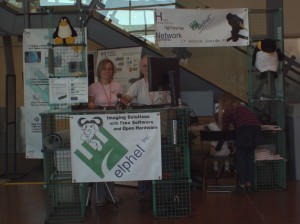“Zoom in. Now… enhance.” – a practical implementation of the aberration measurement and correction in a digital camera

Deconvolved vs. de-mosaiced original

Deconvolved vs. de-mosaiced original
We were assembling four of the nc353_369_hdd camera kits with internal 1.8″ HDD. Unfortunately, when we assembled them – none worked, on the serial console output we could see unhandled interrupts leading to kernel panic when we just tried to format the disk. And the same on all of the 4 cameras, all of the 4 disks, so that could not be a problem with the particular board or device.
Yes, the disks we purchased – 120GB Toshiba MK1231GAL were new for us – we never used them before, but those that we tested earlier were not available. So we looked at the specs and concluded that they should work – same PATA, same ZIF connectors.
texture_tiles
When we started working on Eyesis project our first goal was to make the panoramic head as compact as possible to reduce parallax between sensors. That not only reduces the stitching artifacts but also decreases the minimal distance to object without dead zones between the individual camera.
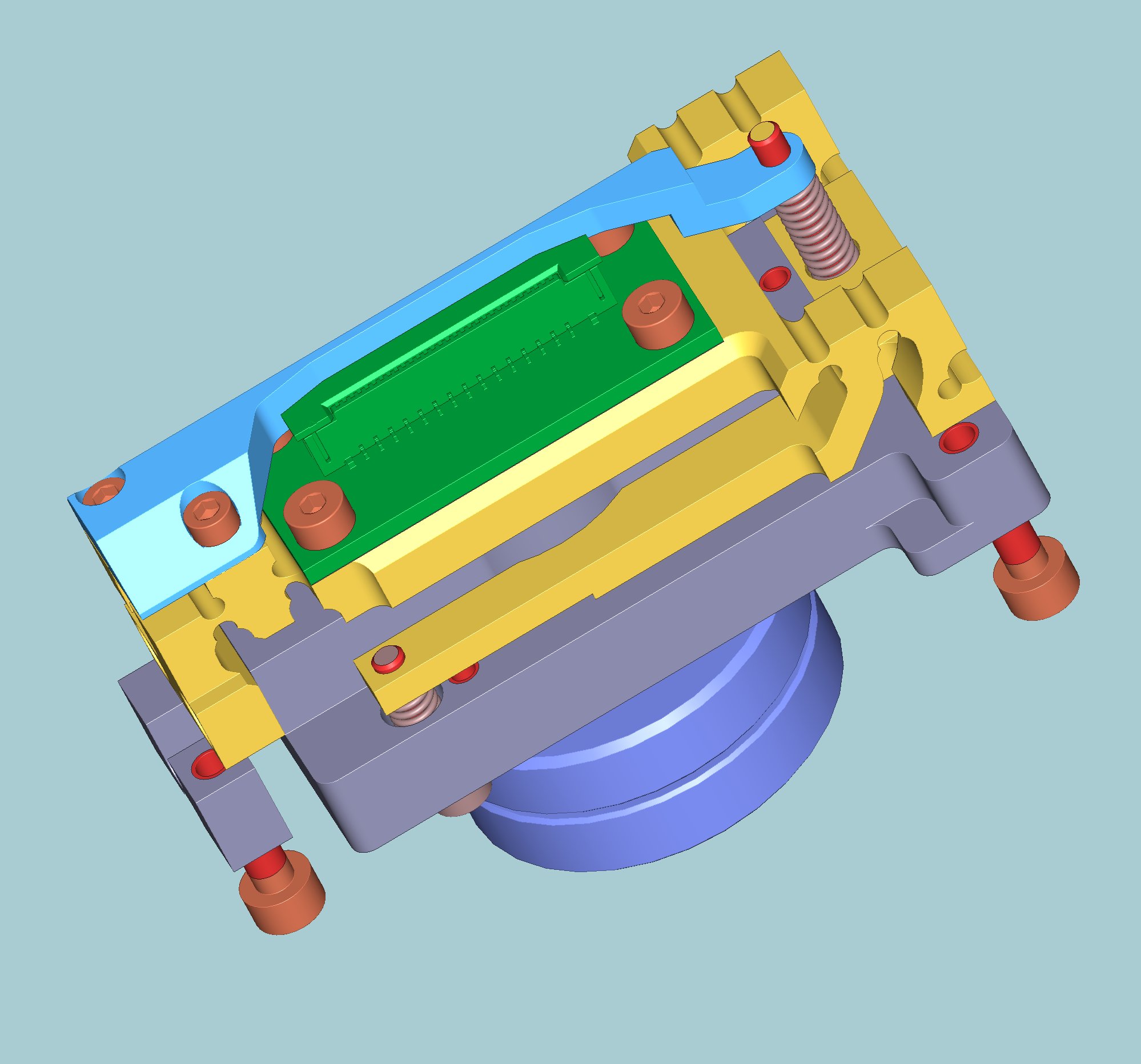 The first practical step was to reduce the PCB area around the sensors, especially in one direction, so multiple camera boards can be placed closer to each other, For that purpose we preserved the basic design of the proven 10338 sensor board, just changed the layout to make it more compact. The board 10338D is just 15mm wide – more than twice less than the older design.
The first practical step was to reduce the PCB area around the sensors, especially in one direction, so multiple camera boards can be placed closer to each other, For that purpose we preserved the basic design of the proven 10338 sensor board, just changed the layout to make it more compact. The board 10338D is just 15mm wide – more than twice less than the older design.
Next step was to run mechanical CAD program and try to place the boards and lenses. Most of the Elphel cameras were designed for the C/CS-mount lenses, but when I tried to place them I immediately found out that when using 10 or 8 cameras around even the C-mount thread (CS is the same size but even closer) will be the limiting factor, not the sensor PCB that we already made smaller.
(more…)
The first 3 Elphel-Eyesis prototypes are nearing completion. Even though there were delays from our suppliers we finally received the last remaining parts and can now finish the camera and data storage assembly.
There were concerns that the pole and its attachments could have aerodynamic problems and that the system could be a whistle at higher speeds.
Today we tested the assembled camera shade for acoustical noise while moving at speed 30-55 mph, luckily the tests proved that there was nothing to worry about.
(more…)
Not much progress with the 10373 board in the last 3 weeks – just cleaned up debug wiring and prepared the board for the visit from SlimLogic Ltd. The software for the 373 camera is going to be based on OpenEmbedded and I would like to set up everything correctly before getting deep in the modifying the existent codebase.
Meanwhile we tested the redesigned sensor board (will work with the 373 camera too) to make it smaller. All the current sensor boards (but the ones with a large Kodak CCD) were the same size – 31.4mm x 31.4mm – it did not change since the times of old Zoran 1.3MPix sensor. Since then the sensors became smaller and less components were needed for the power conditioning too.
The sensor board size is especially important for the panoramic video were it is desirable to keep lenses as close together as possible to reduce the effect of the parallax. For the still imagery panoramic photos it is possible to rotate a camera precisely around the entrance pupil of the camera lens, but for the video (or even some imagery) it is not a solution.
(more…)
Finally U-Boot is running on the new board – it took two full days (and partially -nights) to make that happen. Initially I had no idea what exactly happened when control was passed to u-boot (I already knew that memory is OK and the u-boot image ion the board’s memory is the same as generated on the host and serial port software was under suspicion, so I looked for an independent (of the UART) way how the software could tell me that it reached some points. Obvious solution – general purpose I/Os, but unfortunately most of them are either routed on the inner layers or have multiple functions (shared I/O pins) – and I did not know if any of the software (ROM boot, first stage UBL or U-Boot itself) control them. Just one GPIO pin was not shared and had easy access – connected to the 64-pin QFN package with 0.5mm pitch pins – pins are on the sides, not under the belly as on the BGA ones, so I just soldered a wire to that pin and was able to watch it with oscilloscope.
With that one-bit “printf” life got easier – I was able to find that the serial port output was the one having problems. In most cases it just silently got stuck, but sometimes the serial port was sending out 5-bit zero data (seems like control register that was programmed to 8n1 initially, got zero written to it and switched to 5n1. I still do not understand what did I do wrong and why supposedly working software failed in my case. I resolved the problem by replacing the 8-bit UART registers (separated by 3 dummy bytes) with the 32-bit ones – same as was done in the first initial bootloader that I already had working. With that small mystery unresolved the u-boot is now running as you can see on the screenshot.
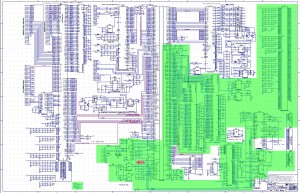
As the board survived the power-up test I was able to start testing more tricky parts – those that require software to run in the processor. As I never dealt with TI DaVinci (or any other ARM processors) before it is going slowly. Production cameras will probably run some flavor of the OpenEmbedded, but for hardware testing I decided to take a shortcut and use whatever is recommended and is available for download on the processor manufacturer’s site – Texas Instruments. And that is based on Monta Vista distribution. I had to agree with their EULA that I took time to read carefully. It seems that license prohibits me to even describe my experience with it. So I will not do that – anyway it is a temporary solution that will never go beyond a single prototype board.
Next thing to do was to try to boot something to the processor and here again – I used the recommended bootloader software that (host part of it that communicates with the program running on the target – the processor being booted) turned out to be written in C# – the language that I thought I’ll never have to use. But – that thought turned out false, especially as there was nice documentation how to use mono, and explained that I need to upgrade the version that comes with Ubuntu otherwise the bootloader will get stuck. And it did really, so that recommendation is still current – at least for the 9.04.
With the patch it worked (at least did something), but only until I decided to recompile the software – I wanted to add some debug code to get some proof that it loads anything. The software is provided as an archive that includes both source and built code and initially I tested just the compiled version. Compilation failed. First I found that I can disable the non-GNU/Linux branch in the top Makefile as I did not needed it. But still it complained about the problem in the C# code itself – the problem was fixed by adding “(Byte)” before “0xFF” in one file – that was my first experience with this language.
With that solved I tried to modify configuration, compile and run u-boot (actually there is a version u-boot-ti that at least knows about the dm6467 – main branch does not have it). Spent a whole day but no success so far, and I could not be sure – is it the software/configuration bug or the system memory (2 of the DDR2 chips) do not work properly – that was what I was really afraid of.
That memory consists of the two fine-pitch BGA chips (two large cyan colored rectangles on the images above) , mounted directly opposite to (on the other side of the PCB) the DaVinci chip (large white square). All the signal traces (red on the images) go to the nearest blind microvia (most – only a fraction of a millimeter), then dive to the inner layer, go there (brown traces) until a buried via that brings them one layer from the other side (cyan) , finish their travel and resurface through a microvia near the destination (blue traces). Both microvias are in most cases under the chip bodies – CPU and memory. So no chance to reach them with a oscilloscope – I had only to hope that the design, PCB manufacturing and BGA assembly did not have a single error. So I put aside u-boot troubleshooting and made a dirty trick – modified the bootloader software (that I already was able to compile) so after loading u-boot code to the DDR2 memory it sent all of it back to the host in the same format as “hexdump” utility does. And all 90KB or so matched perfectly, so one of the critical milestones is over – there is working TMS320DM6467 processor that interfaces with the host over USB and has 256MB of the working DDR2 memory. Now I’m sure that there is some my misunderstanding with u-boot that holds me from running it.
The image above the posting shows the 10373 circuit diagram with the green over the parts that are tested and seem to be working as designed. There is a small red rectangle there – the problem caused by my laziness to play with cp2103 evaluation board – I missed that GPIO pins can only operate as open drain outputs, can not be configured as push-pull ones (at least I could not figure out how to do that).So I’ll have to put a small transistor there (as an inverter) on the prototype and add that to the list (so far only one entry) of the changes to the PCB in the next revision.
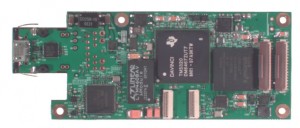
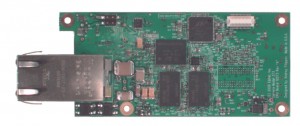
So far – so good, after installing most of the components I tried to power up the board. No smoke, power supply voltages (at least those that do not need software to be turned on) seem to be correct, none of the components are hot.
Next step was to connect USB cable to the programming port – there is a cp2103 bridge chip on the board that is connected to the serial port on TMS320DM6467 – port that can be used to boot the system while the flash memory is empty.
When I just started design with this Texas Instruments chip the datasheet was showing network boot mode (similar to Axis ETRAX we used in all our previous cameras) but later that mode disappeared from the documentation (probably TI ran out of the ROM space) so we had to use another way to program the system so it would be both
The USB connection seemed nice – it is commonly used for the firmware installation, uses regular cables and the port can be used as a system/debugging console during normal operation.
I selected a small (5mm x 5mm) Silicon Labs CP2103 converter as it has additional general purpose I/O pins that can be used to switch between boot modes and generate reset signal for the CPU. This chip seemed to be widely used and to have standard Linux drivers. I was not so sure about those extra GPIO pins support, but noticed that Silicon Labs have some mention of the Linux software, so I’ve purchased their evaluation board to be able to experiment with that software without doing it on an actual board. But I never tried it until the time came to connect the 10373 board. So I opened the evaluation board box, connected it to a computer and – noticed, that there is no support for the extra pins in the regular driver that I’ve got with Ubuntu 9.10. And the driver provided by the manufacturer did not compile with the kernel I’ve got. So I had to spend half of the day figuring out how those drivers work and how to make one that will work on my computer.
That combined driver (I ported only GPIO control from Silicon Labs driver to the one provided with the system) eventually worked and I was able to turn on/off four LEDs on the evaluation board. It required some guesswork and testing as I could not find any documentation on the internal registers and which bits control setting of the GPIO pins – only their API description that assumes usage of some binary-only *.DLL files that may probably work with WINE.
Anyway – I have now a working solution – modified driver and a small application that issues ioctl calls to control GPIO pins. That part also seems to work with 10373, but that is as far as I could go before actually coding for the new processor. And that promises to bring a lot of fun 🙂
A short break from the 373 camera development – Elphel presents our products and philosophy at UTOSC-2009
